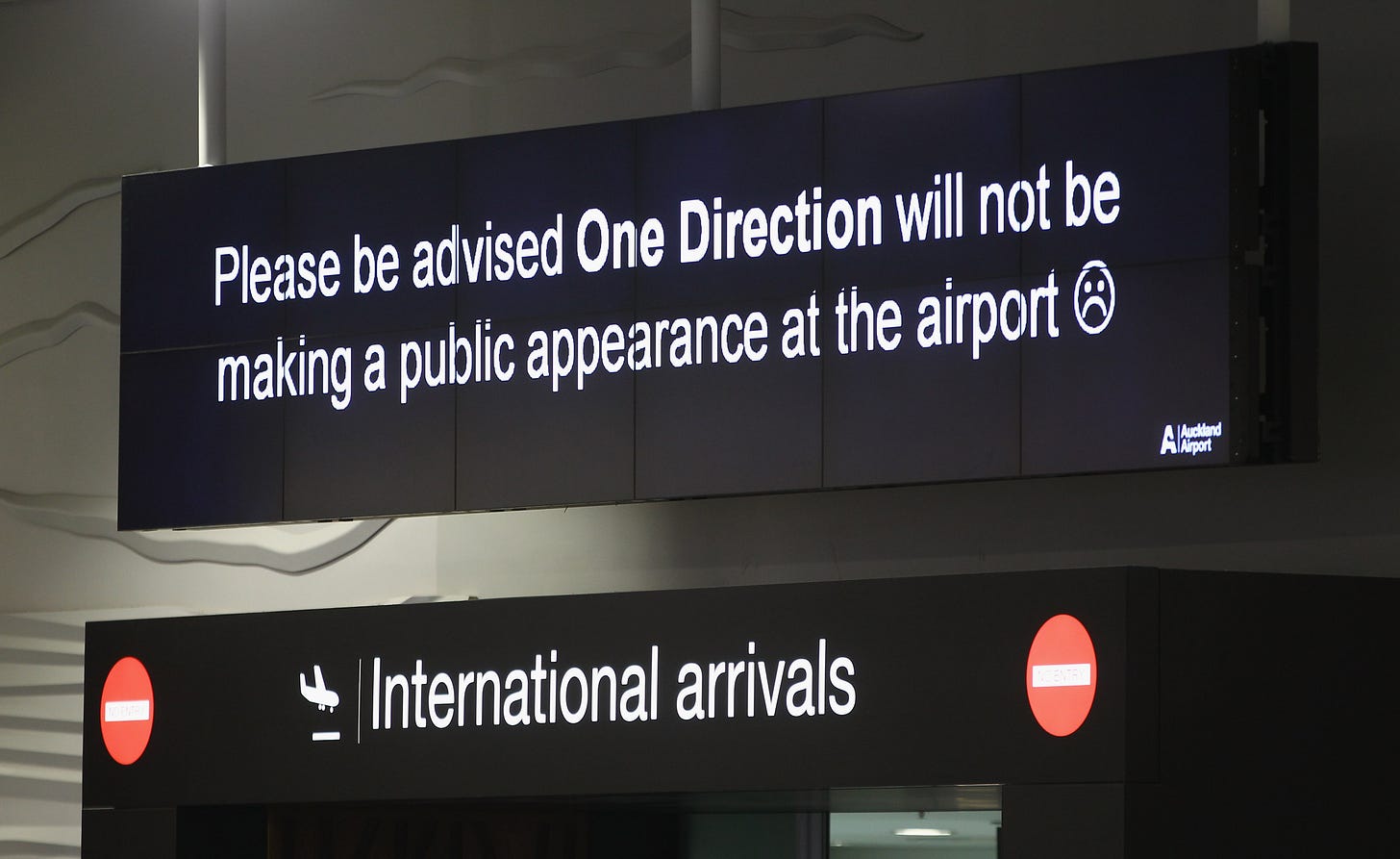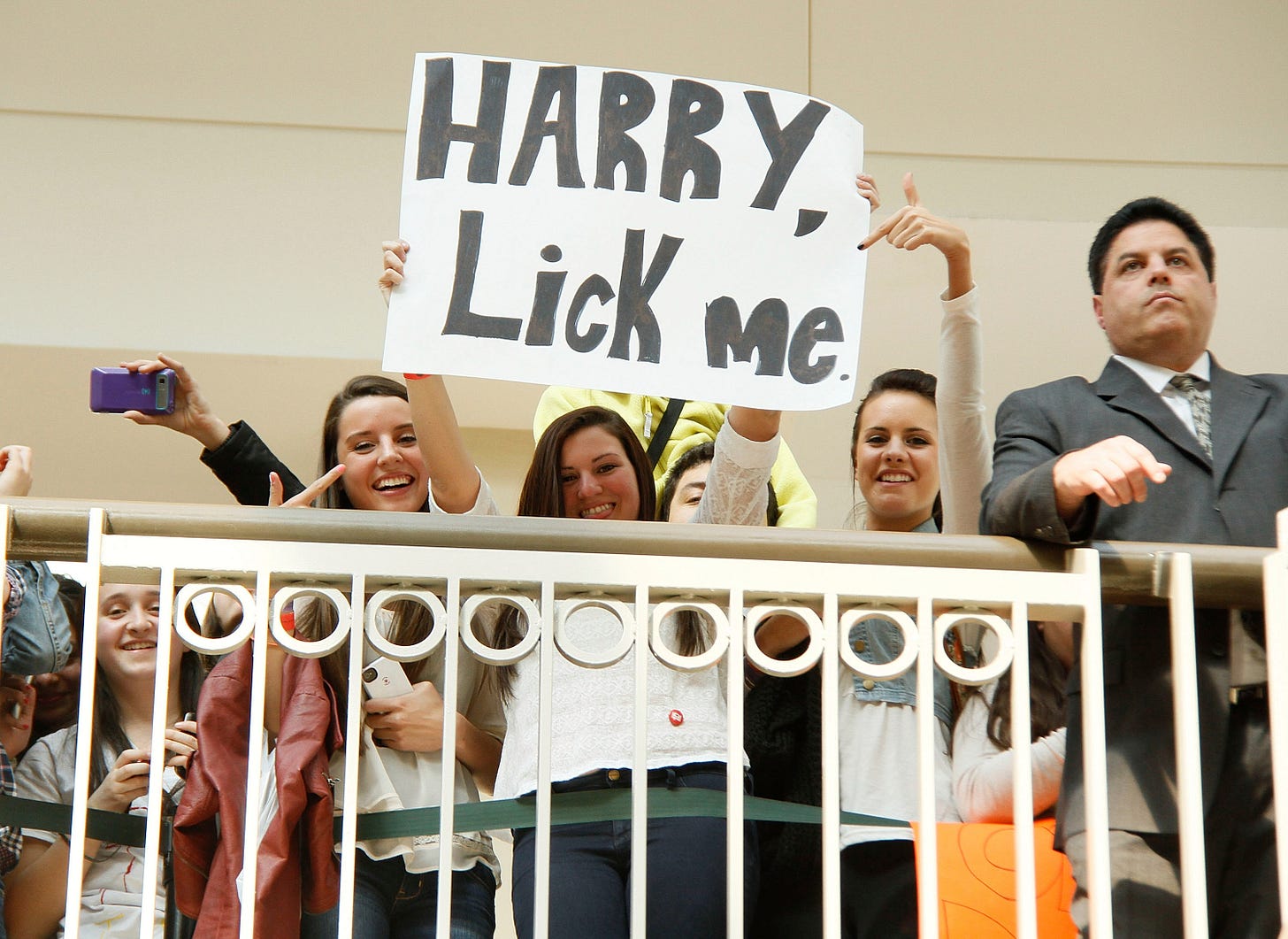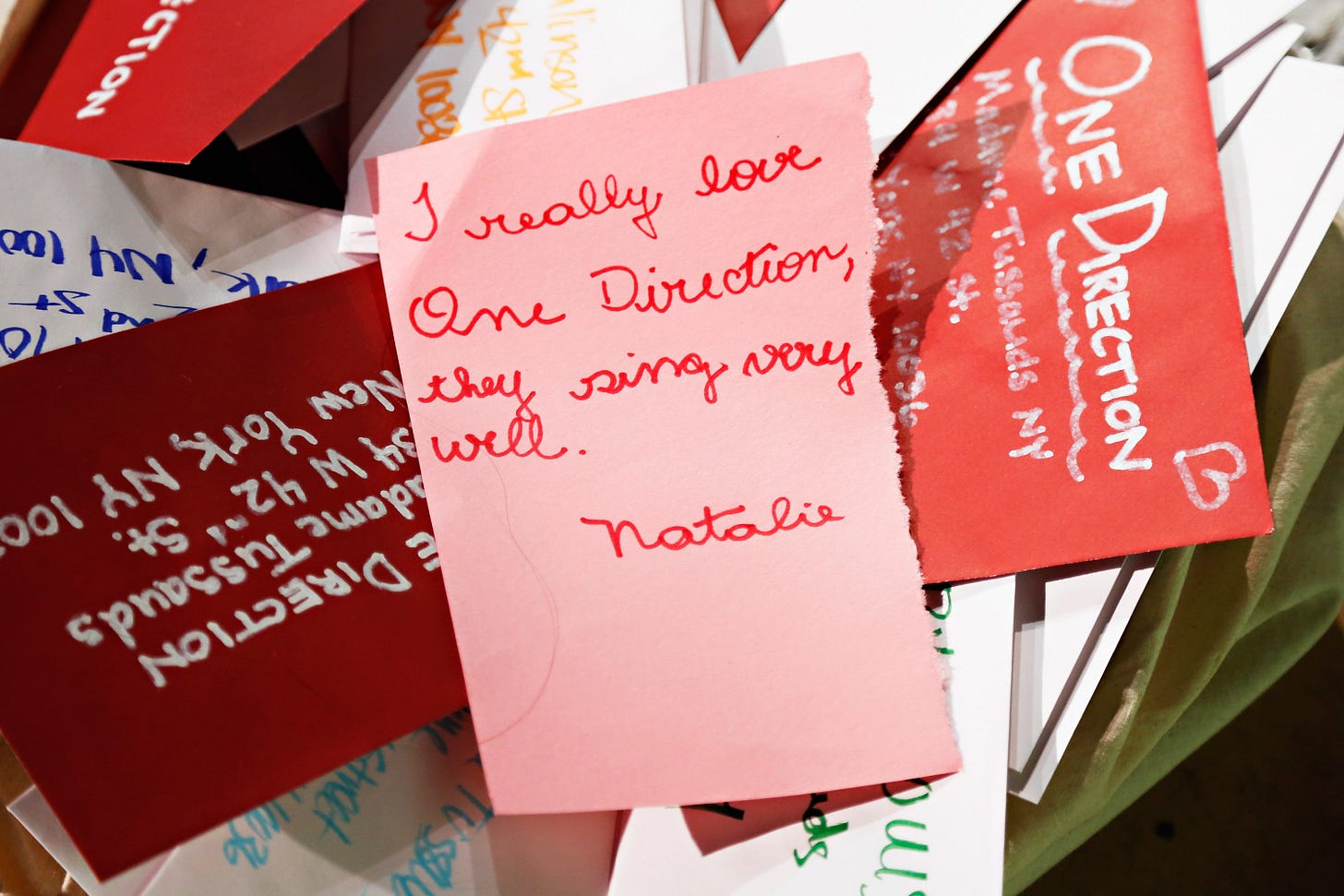the pain and euphoria of being a "pandemic Directioner"
it's been a decade since 1D's historic "Where We Were" tour but we all wish it was 2014 again
welcome to strong feelings! Essays by writers we love, in which they share their most impassioned opinions on a given subject. In today’s strong feelings, writer Aamina Inayat Khan unpacks the uniquely unbounded world of the internet in the 2010s through the lens of One Direction fans past and present.
Emma, 22, could have seen One Direction in concert back in 2014. The “Where We Are” tour tickets were her birthday present to her younger sister, but Emma refused to go. “My friends were interested in One Direction, [but] I was like, I’m not like other girls…Now I feel like I missed out on an opportunity to see them together.” Emma, who was in elementary school when the band was formed on The X Factor in 2010, wasn’t a fan during the six sweet years that the band was together.
One year later, Zayn Malik would leave One Direction causing tumult that could be felt all over the internet. “Zayn leaving One Direction is one of the most memorable non-death music events from my lifetime,” one fan wrote on Reddit. “My best friend’s little sister had to get picked up from middle school by her mom because she was crying so hard,” said another. “Historic. Even my grandfather heard about it.”
Emma was none the wiser, until one day in late 2019 — coincidentally the day before Harry Styles released his second solo album, Fine Line — to listen to the band’s entire discography. Once the pandemic hit the United States a few short months later, she found herself watching hours upon hours of One Direction TikToks and old video diaries of the band during The X Factor UK. The infatuation hit an all-time high when she started making her own videos about One Direction on her TikTok account, @lou1spr1nce, which quickly grew to almost 36k followers.
The fandom is active, even all these years later, but Emma hasn’t posted on the account since August 2023. Though she says she can’t point to a real reason why she stopped, being known on the internet as a late bloomer in the One Direction fandom certainly played a role. “There would be people in my comments saying things about how I was a pandemic Directioner,” she says. “I was just trying to avoid that.” After all, “pandemic Directioner” was certainly meant to be derogatory.
Rank-pulling and infighting between older and newer fans exist in many pop group fandoms — and virtually all fandoms in general — but ultimately, whether you’re an OG or “pandemic” Directioner, both groups yearn for the same thing: the kind of proximity to the band and its memory that was endemic to the online culture of the early '10s. The internet has moved so rapidly since then that the intimate, seemingly “underground” feeling that existed online not too long ago will likely never be created again. Whether you were there when 1D was formed in 2010 or you discovered them after their dissolution, there’s a nostalgic burn to experience the way things used to be, whether again or for the first time. It was its own internet Woodstock.
A decade ago, One Direction was riding the wave of one of their career highs. They had a stacked year: touring from April through October, then prepping for the release of their fourth studio album “FOUR” that November. During One Direction’s rise, the internet was so different. They were created just as young people were starting to flock to social media — coincidentally the same year that Instagram was founded and when Tumblr hit one million users (2010).
The years following would be the Wild West era of the internet. The virtual barricades put up by artists now were nearly non-existent then. You could engage with your favorite artists online, because that’s what they were doing, too. Halsey posted cryptic lyrics to her blog and Taylor Swift rewarded her most loyal Tumblr fans with invites to her home for to listen to new songs during her “secret sessions”. Tumblr is where people like Halsey and Hunter Schafer and Petra Collins went from kids to artists to stars, and we watched. That era of the internet invented a new kind of fame. And I have a pet theory that OG fans’ defensive nostalgia has less to do with One Direction’s smaller flame back then, and more to do with the fact that it’s impossible to recreate a moment like that now that the artist-to-fan relationship feels less organic.
One Direction, during their active years, was not a band for cool kids, though truthfully, no band really is until they’re over. It’s so common now, but in the ‘10s the idea of finding people through the Internet was new territory and sharing those stories with fellow Directioners provided lore that fueled the fandom. “One Direction fans would claim that at the height of One Direction, they were able to come together to hack airport security cameras in order to watch them.” Kaitlyn Tiffany, author of the book Everything I Need I Get From You: How Fangirls Created The Internet As We Know It told editor of The Verge Nilay Patel. Similarly, Jules, 26, a long time Directioner and her friends started looking for fellow 1D fans on the chat room site Omegle, then later on Tumblr. She recalls befriending a girl on Tumblr who claimed to have hooked up with Harry, answering anons about the situation. “In the moment it was like, did it matter if she was telling the truth? Not really. Cuz so much of it was about the fantasy. For me that was where parasocial relationships started. I wonder if, for people now, [One Direction] being in the past makes it feel more separate from you.”
It’s not just about who the members of One Direction were to each other. It’s who they were to the early fans and how they were documented and then disseminated online. The era when One Direction was active is memorialized by stories told by the fans who were there, and in doing so, they become characters too. “There’s that idea of, ‘I wish I was a teenager back when Tumblr was huge,’” says Jules. “It’s the Arctic Monkeys shit and that photo of all those indie kids up against that wall. The One Direction part of it was just prime girlhood.”
Nowadays, the youth cultures that existed on Tumblr a decade ago have evolved and they’re totally coloring all of mainstream pop culture. The amateur photography, the music, the clothes — Tumblr girls are now grown adults with careers and families. But the most fascinating part is how many young people today talk about having missed their window online. “With how big Harry is [now], the odds of me ever being able to see him [live] are so slim,” Emma sasys.
Does the nature of a parasocial relationship change when a band has broken up? Back then, the idea that you could meet them was slim, but real. It was different from the way things are now, where celebrities establish very clear privacy boundaries, especially in fandoms like K-pop. In the ‘10s, fans met their idols all the time. While nothing to be celebrated, there were even fans who were famous for how good they were at finding and meeting celebrities — people like Stalker Sarah and Boopsy16 being notorious across fandoms. Liam even recognized one of them following the car in the band’s episode of Carpool Karaoke.
The Internet was so new, not just for fans, but also for celebrities. No one was used to posting photos, only for every pixel to be analyzed for clues. Looking for artists in public was fairly easy and a lot of fans who grew up in LA and New York stalked them as a hobby. “The security was definitely just not even there,” says early fan Sophia, 23. “Everyone was just like, yeah we’re finding them. So [it] was exciting and fun…Obviously I'm a kid. I don't understand that maybe this isn’t good for anyone involved. Crazy fans who do bad things to the people that they stalk, no one was ever concerned about that.” One good thing about the maturing of the internet is that nowadays celebrities know how to avoid it.
The fans who found One Direction post-hiatus are luckier than contemporary fans of The Beatles or The Smiths. The individual members are still touring and have their solo careers. It’s not totally impossible to engage with them. One fan who rediscovered them during the pandemic, Kru, 24, moved from her home country, India, to Canada, where she could see the individual members of One Direction tour. “A huge deciding factor of picking where I was applying to schools was getting to see these people live. It sounds so stupid. If I talk to my parents, they’ll never know I did this for [One Direction],” she said.
As we’re in the thick of the resurgence of early online culture, it feels like we’re too close to the eye of the storm to know why a band like One Direction has stuck around like glue, but it’s clear that social media played a huge role in upping the ante on the fan experience. There’s a video of Niall walking by a crowd of fans and paparazzi and the paps are telling the fans to get out of the way so they can get their photos. Niall says, “What do you mean ‘get out of the way?’ They pay my bills, not you.” Maybe it’s because One Direction is not just a band, but the origin story of so much pop culture. It’s biography. It’s lore.
The more this whole thing unfolds, the nostalgia, the you had to be there, the new fans, the infighting, the more you realize that this whole thing is kind of an old story. I didn’t feel it in the moment back in 2014 that One Direction would ever be legends, so it’s hard to suddenly realize that this story is headed in the same direction as the rest of them. The Beatles had this kind of fame. Oasis, Fleetwood Mac, just about any modern music sensation. There’s cultural currency in saying you saw them live while they were still together, or while they were still alive. But that’s only true because they’re timeless enough for people to discover them for the first time forever.











as a 2012 directioner i loved this so much!! so much of what i know about the internet (and the reason i got on it) is all because of one direction. it’s truly so crazy how big they still are and watching people discover them now just goes to show the massive scope of their cultural influence. such a great read!!!